Since the concept was unveiled in 2021 and the production model unveiled in early 2024, we were eager to get behind the wheel of the new R5. It will undoubtedly be one of the stars of the next Paris Motor Show, from October 14 to 20, in Paris, and a very important model for Renault.
The diamond brand is betting on this new R5 “made in France”, with assembly carried out in the Douai factory (North), to establish itself in the electrical sector with an eye on the deadline of 2035 in Europe and the sales ban of New thermal cars, including hybrids.
The manufacturer does not hesitate to establish a parallel with the original Renault 5, launched in 1972. A model that marked its time as a multipurpose vehicle, anti-oil crisis vehicle and also a symbol of the arrival of a second car in some French homes.
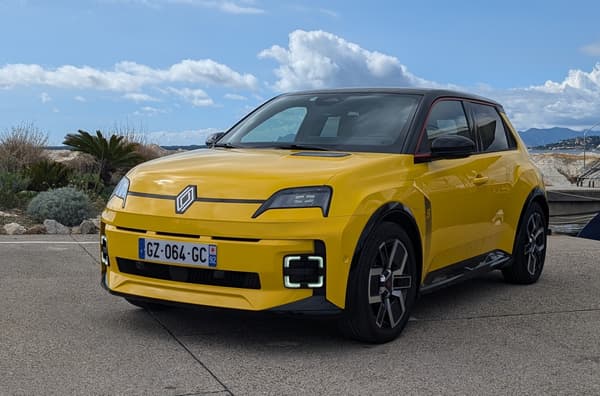
And this new R5 aims to once again be an anti-crisis solution. An environmental crisis, with 100% electric development as a remedy and this 2035 horizon in Europe, and a social crisis, with the desire shown by Renault to democratize the zero-emission car.
A revitalized and unanimous design
At first glance, the car does not go unnoticed, especially in this yellow, one of the launch colors and which also makes the link with the 2021 concept. And we can say it, this new generation R5 leaves its small impact, with this design. that evokes the older generation, while fully projecting itself into the future. During our test in and around Nice, we no longer counted the number of thumbs up and interactions with passers-by recounting their memories with the old model. Or rather the old R5s.
In fact, it is the synthesis of three models: the original R5 from 1972, the Super cinq that succeeded it from 1984, and even the Turbo version with its greatly widened fins. Gilles Vidal, Renault design director, explained to us in February this strategy to revive “the spirit of the R5” of a “popular, affordable and beautiful small car, with an attractive design at first glance.”
If cars have grown a lot lately, this new R5 maintains a fairly compact format for a 5-seater. At 3.92 meters, we should expect a versatile but small city car. A little bigger than a Twingo, but shorter than a Clio.
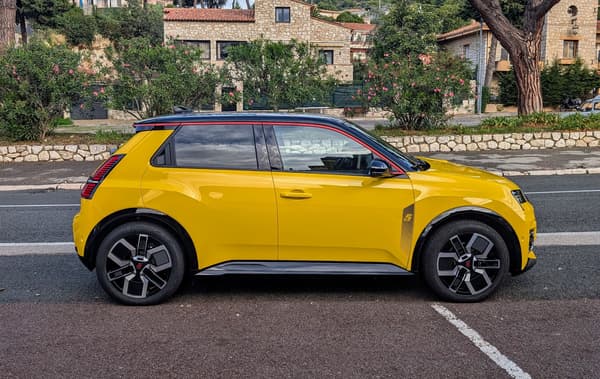
On the hood, a quite original detail: a light allows you to see at a glance the car’s charge level from the outside when unlocking it and which evokes the old air intake. Let’s see if this is really useful, but it is a nice symbol of the reinvented past that this new R5 represents, with each bar making up the number that represents 20% of the battery.
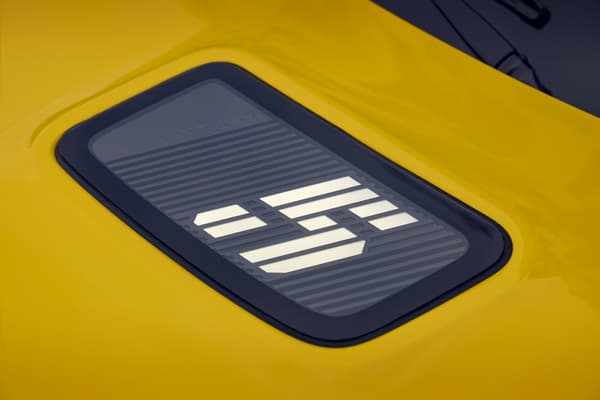
This past-future approach is also found in the rear lights, which are reminiscent of previous generations but which also serve here as air deflectors to improve aerodynamics. These lights, but also the spoiler or what is done on the wheels, allow you to gain just over 20 kilometers of autonomy.
The trunk has a volume of 326 liters, with a double bottom that allows, for example, the introduction of charging cables, offering an additional 41 liters.
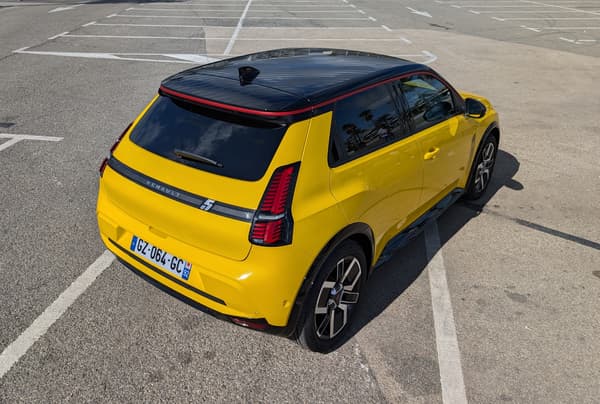
A cozy and technological interior.
Inside there is still enough space despite the compact size of the vehicle. This R5 inaugurates the new AmprSmall platform, dedicated to the group’s small 100% electric models, with an optimized wheelbase. The space between the front and rear wheels is 2.54 meters, the same as in a Clio while this R5 is 13 centimeters shorter.
Between the seats, the overall vintage atmosphere and the modernity of the meter screens, Renault has successfully reinterpreted its legendary model.
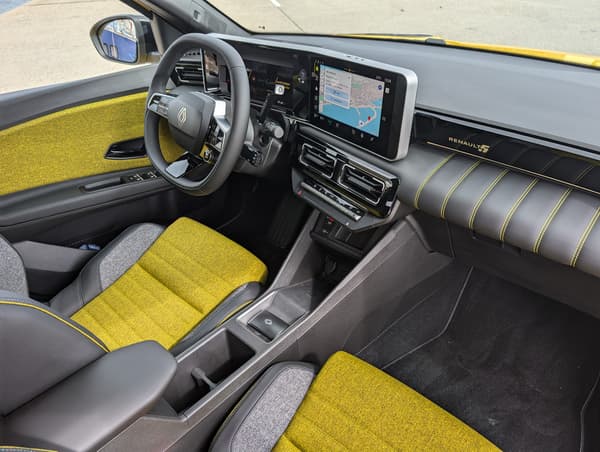
We have a combination of 10-inch screens, for the digital counters and the touch screen. Both are surrounded by a metallic-colored plastic frame, which gives the feel of an XXL “high-end smartphone,” with three small physical keys for volume and sleep at the top.
The infotainment system designed with Google, but still compatible with Carplay for iPhone owners, remains a current reference in the market since its inauguration in the Mégane E-Tech.
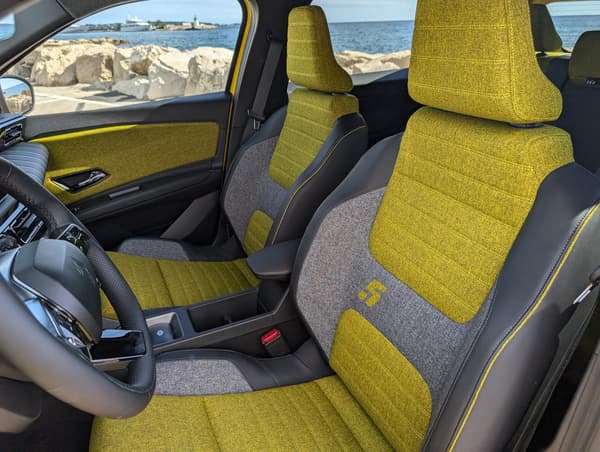
On the negative side, space for rear passengers is quite limited, something quite logical in such a compact format and with a not so ridiculous trunk. Rear passengers who will not have USB ports either. The front is quite well equipped at this level, with two USB type C ports, a 12V socket and space to charge a smartphone by induction.
Last drawback, the three convenient ones to the right of the steering wheel: from bottom to top, Renault’s “historical” satellite for audio controls, windshield wiper control and mode changes (forward, reverse and neutral) . We can easily confuse these last two commands, which are still quite similar. Compared to a Tesla Model 3 that no longer has any switches behind the steering wheel, a middle ground can surely be found.
It’s also a shame to only have a low definition reversing camera, it’s a bit of a blot on such a successful and modern car.
Behind the wheel, very good first impression
On the road, this new R5 is agile, comfortable and dynamic. Its compact size allows you to easily navigate around town with very direct steering, but is still versatile enough to easily travel on the road. All this with fairly well-worked acoustic insulation to enjoy the silence of electricity.
The 110 kW (150 horsepower) and 245 Nm motor offers good performance without being lightning. Acceleration from 0 to 100 km/h is thus announced in 8 seconds, but the return from 80 to 120 km/h in 6 seconds. For those who have better features, they will have to turn to the Alpine A290, the “sporty” cousin of this R5.
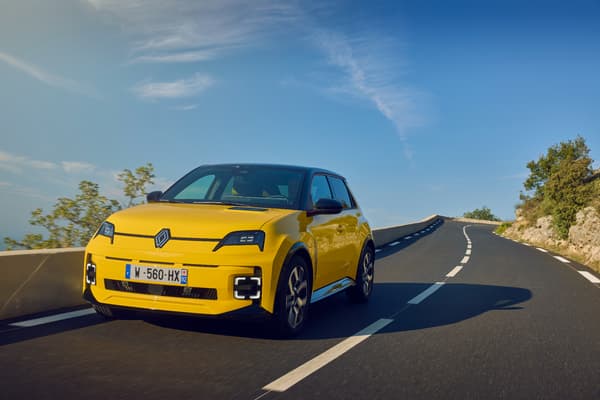
The 52 kWh 400 V NMC battery promises 410 kilometers of autonomy. During our use test in the city, on small roads and on highways, our consumption was below 15 kWh per 100 km, enough to cover at least 340 kilometers on a single recharge.
At this charging point, the new R5 can absorb 11 kW in alternating current, or 4h30 for 10 to 100%. And 100 kW in a direct current fast charging station, enough to go from 15% to 80% battery in 30 minutes.
And this R5 is prepared for the future, which we hope will be near, with the introduction of bidirectional charging: it will soon be possible to share the electricity of your R5 with the grid when it is connected at home for a “smart grid”. typographic uses. Enough to potentially add the remuneration of energy providers in exchange for this provision of their battery to further reduce the cost for the interesting use of electric vehicles.
The price: cheaper versions are expected by 2025
Renault begins marketing high-end versions of its R5. The Techno finish thus starts at 29,500 euros and 31,500 euros for our version in the Iconic five finish. A difference that may seem justified with this finish that comes with heated seats and the main driving assistants (pack at 1,000 euros in the Techno version) and parking.
But it is still a bit expensive for a city car, knowing that these prices include the deduction of the 2024 ecological bonus of 4,000 euros. Due to its design and performance, it certainly has nothing to be ashamed of compared to the Fiat 500 or the electric Mini, but Renault’s desire remains to democratize the electric vehicle.
Therefore, we eagerly await the versions equipped with a smaller battery, 40 kWh, or 312 kilometers of autonomy, and with less powerful motors, 70 kW (95 horsepower) and 90 kW (122 horsepower).
Starting in January, a version will be marketed at 27,990 euros (not including the ecological bonus, which is expected to drop in 2025) with this lower capacity battery, but which a priori is still largely sufficient for an electric city car not intended to long trips.
The 52 kWh version seems more intended for those who need “reassuring” autonomy or who cannot charge at home. We can then consider one recharge per week at a public terminal or at the workplace for daily commutes.
Beyond the strategy of selling high-end variants with a more comfortable margin initially, Renault surely also wanted to wait until 2025 for its truly affordable R5. The CO2 emissions thresholds that must not be exceeded in new car sales will be reduced. Obviously, it will be necessary to sell many R5s so that the Renault group does not have to pay heavy fines to Europe.
A little later, in 2025, Renault plans a version below 25,000 euros (still not including bonuses). Essential to face numerous competitors, such as the Citroën ë-C3 and models from Chinese brands.
Source: BFM TV

